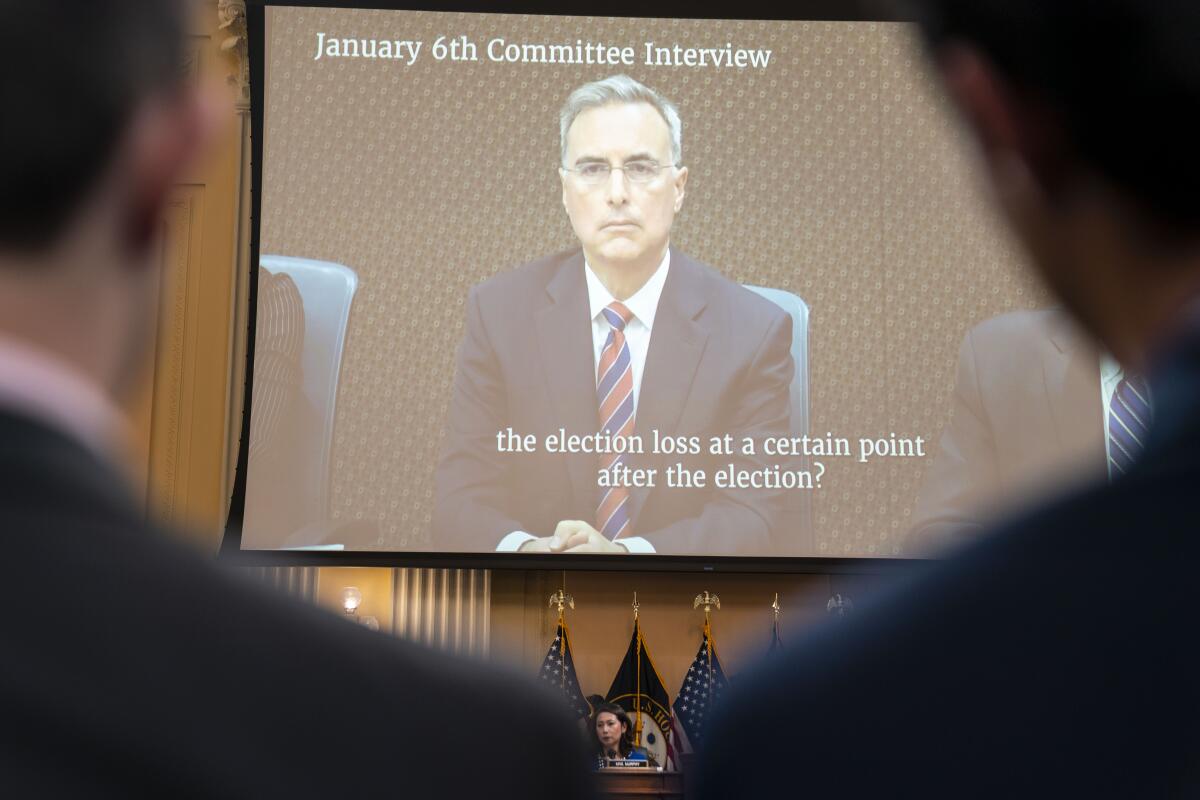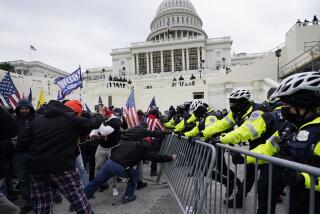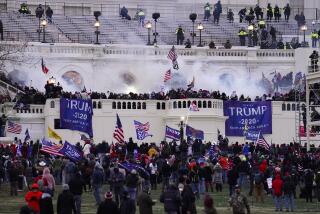‘Just following what he said’: Takeaways from the Jan. 6 hearing on Trump’s actions and the riot

- Share via
WASHINGTON — The House committee investigating the Jan. 6, 2021, attack on the Capitol spent its seventh hearing Tuesday focused on the origins of the mob and former President Trump’s role in inciting it.
The hearing covered the period from Dec. 18, 2020 — when a wildly contentious meeting took place in the Oval Office between Trump White House aides and conspiracy-minded outside advisors — to the morning of Jan. 6.
Led by Reps. Jamie Raskin (D-Md.) and Stephanie Murphy (D-Fla.), the hearing featured extensive testimony from former White House counsel Pat Cipollone, who was interviewed by the committee for eight hours Friday.
Cipollone has emerged as a key witness over the course of the hearings, as others who have testified made note of his concerns over the legality of Trump’s actions in the final days of his administration. Cipollone was present at several moments of interest to the committee, including the Dec. 18 meeting.
The hearing closed with testimony from Stephen Ayres, a Capitol rioter who described how he came to believe the presidential election had been stolen and how his life had been changed by his participation in the events of Jan. 6, 2021.
Here are four key takeaways from the hearing.
More details on an ‘unhinged’ Oval Office meeting
The hearing presented new details about a Dec. 18, 2020, White House meeting that former aide Cassidy Hutchinson described as “unhinged.”
Two days earlier, Trump advisors had drafted an executive order that would have called on the Department of Defense to seize voting machines. The order would have appointed a special counsel to oversee the effort and given that person the power to charge people with crimes. The plan was to name Sidney Powell, a Trump lawyer who’d been pushing a conspiracy theory that the Venezuelan government had tampered with voting machines, to the role.
The Dec. 18 meeting turned into a heated debate pitting Powell and the outside advisors against Cipollone and other former White House staffers.
“I didn’t think she should be appointed to anything,” Cipollone said during his testimony of the plan to elevate Powell.

As several attendees described in video testimony, the meeting started with Powell, former Overstock.com Chief Executive Patrick Byrne and former National Security Advisor Michael Flynn being escorted into the White House by a junior staffer. Cipollone and former White House counsel Eric Herschmann rushed to join in once they learned that the president was meeting with the group unsupervised.
“I was not happy to see the people in the Oval Office,” Cipollone told the committee. “I don’t think any of these people were providing the president with good advice, and I didn’t understand how they had gotten in.”
The six-hour meeting was described as contentious, with name-calling and shouting as the outside advisors attempted to push Trump to follow up on unfounded claims of election fraud.
Asked about the fraud allegations he presented regarding Dominion Voting Systems machines and election interference from Venezuela, Iran and China, Flynn invoked his 5th Amendment rights.
Organizers had concerns ahead of Jan. 6 rally
Soon after that meeting, Trump sent out a tweet urging his supporters to come to Washington, D.C., on Jan. 6: “Be there. Will be wild!”
The committee outlined how that tweet mobilized Trump’s supporters, including those with ties to far-right groups, and led to an uptick in threatening and white nationalist messages on sites that included thedonald.win.
As the rally approached, organizers and Trump supporters began asking questions about safety.
Katrina Pierson, a former Trump spokeswoman, started to express concern about the Jan. 6 rally in the days leading up to it, asking former White House Chief of Staff Mark Meadows on Jan. 2 to call her to discuss the event.
“Things have gotten crazy and I desperately need some direction. Please,” she wrote in a text.
Pierson testified in a deposition with the committee that she told Meadows on the phone and in texts that there were “suspect” entities coming to Washington and that she was concerned by the rhetoric espoused by right-wing conspiracy theorist and radio host Alex Jones and “Stop the Steal” organizer Ali Alexander at previous events.
Rep. Debbie Lesko, an Arizona Republican who voted against certifying some of the election results, said she asked leadership to come up with a safety plan for members of Congress, according to a recording of a Jan. 5 meeting with Republican lawmakers.
Lesko said she was worried about how Trump supporters who believed that Congress would actually overturn the election would react.
“When that doesn’t happen, most likely won’t happen, they are going to go nuts,” she said.
Trump ad-libbed key parts of his Jan. 6 speech referencing Pence
The committee described how Trump revised his speech to urge Vice President Mike Pence to refer election results back to the states, against the wishes of his White House counselors.
On the morning of Jan. 6, 2021, Trump inserted a line that said Pence should do so in order to enter history “as a truly great and courageous leader.”
Stephen Miller, a former senior advisor to Trump who helped him write the speech, testified that he spoke with Herschmann, who said the lines about Pence would be counterproductive. The lines were removed.
Later that morning, Trump and Pence had a tense phone call in which the vice president said he would not help block the certification of the election results. In response, Trump called Pence a wimp “and other derogatory words,” Murphy said. During the rally, one scripted reference to Pence became eight ad-libbed mentions.
“President Trump wanted to use his speech to attack Vice President Pence in front of a crowd of angry supporters, who had been led to believe the election was stolen,” Murphy said.
After the Capitol attack, some of the former president’s supporters directly tied his comments to the day’s violence.
Brad Parscale, a senior advisor to Trump’s 2020 campaign, texted Pierson on the evening of Jan. 6 that he thought the president’s rhetoric had directly led to the death of Ashli Babbitt, a Capitol rioter who was killed by police.
“It wasn’t the rhetoric,” Pierson replied.
“Katrina,” he wrote back. “Yes it was.”
Trump’s words influenced Capitol rioters
Ayres, a former Trump supporter from Ohio, testified about how Trump influenced his actions Jan. 6 and what has happened to him since; he pleaded guilty last month to disorderly and disruptive conduct in a restricted building or grounds.
Ayres described how the former president’s messages on social media and at the Jan. 6 rally influenced him to storm the Capitol. He said he followed Trump on various social media platforms and believed the election had been stolen based on what he saw online. He decided to travel to Washington with friends after seeing Trump’s tweets.
Once there, Ayres said, he wasn’t planning to march to the Capitol until Trump riled up the crowd and told them to go. He believed Trump would go with them.
“We were basically just following what he said,” Ayres testified.
Ayres said he left the Capitol as soon as Trump sent out a tweet to disperse the crowd. Since the attack on the Capitol, he has stopped supporting Trump, left social media and no longer believes the election was stolen. He lost his job and has sold his house.
“It changed my life … and definitely not for the better,” he said.
After the hearing, Ayres approached the Capitol Police officers in attendance to apologize.
“I’m really sorry,” he said.
More to Read
Get the L.A. Times Politics newsletter
Deeply reported insights into legislation, politics and policy from Sacramento, Washington and beyond. In your inbox three times per week.
You may occasionally receive promotional content from the Los Angeles Times.










